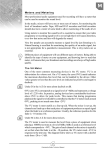Download Manual - TOA Canada
Transcript
OPERATING INSTRUCTIONS AUTOMATIC MICROPHONE MIXER AX-1000A Please follow the instructions in this manual to obtain the optimum results from this unit. We also recommend you to keep this manual handy for future reference. TOA Corporation CONTENTS Description 3 Introduction 3 Features NOM Attenuation 900 Series Compatibility Channel Direct Outputs Logic Outputs Input Channel Controls NOM Attenuation Control Other Features 4 4 4 4~5 6 6 1. Front View 7 2. Rear View 8 3. Installation 9 4. Input Signal Flow Threshold Adjustment Off-Attenuation 9 10 10 5. Input Connections Choosing the Correct Modules Specific Module Applications 11 15 10. Setup Procedure : Mic Input Modules 16 11. Setup Procedure : Mic Channels 16 12. Fine-Tuning the AX-1000A Installation 17 13. Using the AX-1000A System Mute Bus Configuration 1 : Internal Mute ; INT. Priority Override 17 17 18 14. External Mute; EXT.: Using the 900 Series Module Mute Bus Configuration 2 : Using Mute Receive Modules 900 Series 15. Automatic Module Muting Configuration 3 : Internal Mute plus Automatic Module Muting 19 20 6. AX-1000A Configuration : Quick Setup Master Volume Control NOM Attenuation Adjustment 11 16. Stacking (Multiple Mixing) 20~21 11 12 17. Application Ideas 21~22 7. Output Configuration Main Output Connections Remote Master Volume Direct Outputs Logic Outputs 12 12 13 13 8. Operation: Setup Checklist General Operating Considerations 2 4 9. Setting Up Input Modules Choosing Microphones 14~15 15 18. Block Diagram 23 19. Specifications 24 20. Appendix Simplified Block Diagram Setup Checklist 25 26~27 DESCRIPTION The TOA Model AX-1000A is an eight-channel automatic microphone mixer. Using TOA 900 Series modules for flexibility and reliability, it has been specifically designed for commercial sound reinforcement applications. Microphone inputs may be mixed with line-level inputs in any combination. Where potential feedback is of major concern, the AX-1000A incorporates the technology required to gate on quietly, quickly and automatically. The AX-1000A is equipped with channel logic outputs, channel direct outputs, priority-override channel muting and Master/Slave linking for up to ten units. Applications include: •Churches • Combinable function rooms • Conference center systems • Boardrooms • Courtrooms • Teleconferencing and multi-media rooms. Features: Inputs Mixing and Muting Outputs 900 Series compatibility Uses 900 Series input modules Up to 8 inputs, any combination of Mic and Line Gate-on LEDs Link In / Out: up to 80 channels Adaptive Threshold circuit Variable NOM AttenuationOutput Gain from 0 log NOM to Direct Outputs Logic Outputs Master Remote Volume Control terminal transformerisolated, balanced output. 20 log NOM Individual channel Threshold and Off-Attenuation adjustment Automatic or manual mixing is user-configured Internal Mute on any selected combination of inputs Input External Mute on any mutable modules INTRODUCTION The AX-1000A is an economical and very versatile mixer. This manual will help you understand how to include the AX-1000A in highly engineered sound systems. If you are simply installing a single AX-1000A for microphone mixing (with perhaps a line input for music), the procedure is very simple. Basics are covered in Section 3~9: 3. Installation 4. Input Signal Flow 5. Input Connections 6. AX-1000A Configuration: Quick Setup 7. Output Connections 8. Operation: Setup Checklist 9. Setting Up Input Modules You will also find TOA's Input Module Instruction Manual helpful. Most of the time, this is all you need to know to specify and install the AX-1000A. An Installation and Setup Checklist has been included in the Appendix. Copy the pages for a complete on-the-job reminder of setup operations. Because of its rich feature set, an AX-1000A can be used in almost any commercial application. However, if you progress beyond basic applications it is a requirement that you study this manual carefully. Using the AX-1000A's controls in Advanced Applications is covered in Sections 7-11. 3 FEATURES NOM Attenuation The AX-1000A's NOM Attenuation circuitry automatically adjusts gain level according to the number of active inputs. NOM = Number of Open Microphones. Most automatic mixers reduce output according to the formula 10 log NOM. When two mic inputs are active, the system gain is lowered 3 dB; when four are active, the output is reduced by 6 dB; etc. TOA's NOM Attenuation circuitry allows adjustment from 0 to 20 log NOM depending on the system specifications. Consequently, installations incorporating the AX-1000A deliver maximum acoustic gain without feed back. 900 Series Compatibility Each of the AX-1000A's eight input ports accepts 900 Series Mic Level, Auxiliary, Phono, 600 ohm and 10k ohm Bridging, Signal Generator Modules and the T-02 Module for Music-on-Hold. This allows the contractor or specifying engineer ultimate flexibility in system design. Up to ten AX-1000A mixers may be linked together to create a system with a maximum of 80 active input channels. When units are linked, one mixer in the chain is the Master. This is accomplished by setting the rear-panel Master/Slave switches. In addition to the Main Output, the AX-1000A provides Direct and Logic Outputs for each channel. Channel Direct Outputs Channel Direct Output uses are limited only by the application. For example, direct signals can be input to a logging recorder to provide an account of courtroom proceedings while the mixer controls the communications system itself. Or, the Direct Outputs from certain channels can be fed into a second mixer or mixer-amplifier. Logic Outputs The Logic Output is an isolated open collector circuit that will trigger external devices. Applications include video camera control, tape recorder control, and control of distributed speaker systems. Input Channel Controls Each channel has an Input Volume Control. This adjusts channel gain and allows balancing the mixing among the eight audio sources. Behind a front-panel security cover lie the trim controls for each channel's Threshold and Off-Attenuation. The Threshold control adjusts the signal level at which the input switches from 'off' to 'on'. As automatic mixing occurs, the AX-1000A uses this setting as the 'base line' and changes each channel's Threshold in an adaptive manner. Off-Attenuation sets channel attenuation depth when the gate is 'off'. Inactive inputs may be attenuated from 0 dB to as much as 40 dB. 4 Variable Off-Attenuation Adjustable Off-Attenuation allows the fine adjustment necessary to assure smooth channel turn on without missed syllables. When Off-Attenuation is 0 dB, the mixer channel functions as a normal mixer: there is no attenuation of an inactive channel. Variable Off-Attenuation Note : When Off-Attenuation is set to 0 dB, the AX-1000A still utilizes the channel's active/inactive status for its automatic mixing logic. To change the automatic mixing function, use the NOM Attenuation control. Example : Here's an unusual example that shows how flexible the AX-1000A can be. Imagine a game show produced by a small organization with its own video studio where a single mixer must work in a wide variety of situations. Perhaps this game show is staged as part of employee training. An AX-1000A can be configured as four channels of normal mixing (sound effects source, studio paging mic with press-to-talk switch, BG/FG music cassette, and MC's lavalier mic) with four channels of automatic mixing (four panelists or game contestants). The only requirement is to set the Off-Attenuation appropriately. In this example, the module complement would be : Input Module MC* Mic Paging Mic Sound FX Aux BGM/FGM Aux Person 1 Person 2 Person 3 Person 4 Mic Mic Mic Mic Off-Attenuation 0 dB... channel always on 0 dB... channel always on because mic is PTT. 0 dB... channel always on 0 dB... channel always on 40 dB... automatic 40 dB... automatic 40 dB... automatic 40 dB... automatic * Threshold could be reset to moderately high level to gate out rustling clothes. 5 NOM Attenuation Control The NOM Attenuation Control is variable between 0 log NOM and 20 log NOM. This allows the AX-1000A to be adjusted for virtually any multi-microphone application. Often, each microphone in an acoustic space exhibits a particular feedback mode, different from the other microphones. In these cases, 10 log NOM reduces the gain too much when more microphones become active; thus operating the system with lower gain than optimum. In such situations, a setting between 0 and 10logNOM delivers less attenuation with each doubling of active inputs, therefore eliminating unnecessary attenuation. Feedback modes in very reverberant spaces can be additive to degree that greater attenuation than normal is needed with more mics on. A setting between 10 log NOM and 20 log NOM provides more gain reduction than normal as additional microphones become active, preventing feedback. Note: NOM Attenuation affects overall system gain and is totally independent from the input attenuation depth function. Attenuation 20logNOM in dB Multiple AX-1000A's One AX-1000A Variable Attenuation 10logNOM (normal) Variable Attenuation 0dB Attn Inputs Active Inputs Inputs (NOM) Other Features The AX-1000A's Priority Override Mute is especially attractive in conference systems where the chairman must override other delegates. Selection of which channels mute when the Mute Terminals are shorted is preset with a DIP switch. Mute Terminal can be alternatively routed to the module mute bus. A Master Remote Volume Control may be wired to the Remote Master Volume Terminals on the rear-panel to enable control of the system's overall output from a podium, projection booth, or similar location. The Off-Attenuation, Threshold and NOM Attenuation Controls are hidden by a security cover to prevent unauthorized or unnecessary adjustments. The AX-1000A includes the hardware necessary for mounting in standard 19" equipment cabinets. 6 1. Front View 1. Input Volume Control Adjusts input gain, after any gain stage(s) in the chosen 900 Series module. 2. Gate On/Off Indicator Illuminates when the channel gates on. 3. Master/Slave Indicator Illuminates when unit is the Master in a combinable system. Master/Slave switch is on the rear-panel. 4. Threshold Control Adjusts the channel gate-on sensitivity. Turning fully counter-clockwise lowers the threshold, resulting in maximum sensitivity. 5. Off-Attenuation Adjustment Adjusts the inactive-input attenuation depth. 6. NOM Attenuation Control Adjusts the operation of the automatic mixing system's gain-sharing circuitry. (0 log NOM is fully counterclockwise position; 20 log NOM is fully clockwise position.) 7. Master Volume Control Adjusts the overall sound system level. 8. Power On/Off Switch and Indicator LED illuminates when unit is turned on. 7 2. Rear View 1. Remote Master Volume Control Terminals Use a 10k ohm linear potentiometer (10k ohms = no gain reduction; 0 ohm = full gain reduction). 2. Direct Outputs Individual outputs for each of the eight inputs. The signal originates at the output of the module plugged into the port; it is not gated by the mixer. 3. Logic Outputs To trigger external devices. 4. System Mute Terminals 5. Link In When more than one AX-1000A is being utilized, slaves are daisy-chained using Link In/Out. 6. Link Out 7. Main Output Terminals 150/600 ohm barrier strip outputs. 8. Channel Mute DIP Switches Chooses which channels mute in response to a short across the System Mute Terminals. As shipped the default is 'on' (channels respond to a short across the mute terminals). 9. Mute Function Select Switch Muting may be set for Internal Mute; INT., or for External Mute; EXT. For further details see "Using the AX-1000A System Mute Bus". 10. Master/Slave Selector If multiple units are incorporated in a combinable system, one AX-1000A must be the Master. The additional units must be set up as Slaves. 11. Module Input Ports For up to eight inputs. Each active input requires a 900 Series Module. See TOA's Input Module Instruction Manual. 12. AC Fuse Replace only with a fuse of the same rating. Caution: If the fuse blows, please contact TOA dealer. 8 3. Installation Unpacking and Inspection Upon receiving the AX-1000A, please inspect it for any shipping damage. If damage is found, notify the carrier immediately. Rack Mounting The AX-1000A requires 3-unit size. Mounting brackets are provided. Remove the four screws securing the case at the left and right front. Attach the rack mounting brackets. Be certain to only use the screws that are included on the AX-1000A unit. Note: Allow adequate ventilation: do not block the vents in the cover. Do not locate the AX-1000A : In unventilated areas. Where it is exposed to direct sunlight. In an area subject to heavy vibration. In a dusty or extremely humid area. In an area with a high ambient temperature, or immediately adjacent to equipment which generates large amounts of heat. Caution : There are no user-serviceable parts inside. Never remove the cover, or you run the risk of a fatal electric shock. 4. Input Signal Flow Since the AX-1000A has eight input ports for 900 Series plug-in modules, it is completely flexible. Requirements often vary from installation to installation, and the AX-1000A can be configured exactly to suit each one. In order to change a given channel's function, simply specify the proper 900 Series input module. The signal flow from the output of the module(s) is the same for every channel. See Figure 1. This simplified 'map' of the signal flow does not represent the actual circuitry, only the stages of processing that occur. Functions that occur after the signals reach the Mixing Bus have been omitted for clarity. External/Internal Mute buses : The AX-1000A has two Mute buses, External Mute Bus and the AX-1000A Internal Mute Bus. Each one can operate independently, and each one operates at a different stage of the signal chain. Configuring mutes is explained in detail, below. 9 Channel Signal Flow (simplified) Input Ch. 1 Logic Output Direct Output Mute Terminals Threshold Adjustment The heart of an automatic mixer is the circuit that determines which inputs should gate on and which inputs should remain off. The AX-1000A does this by comparing constantly and rapidly an individual channel's level and the levels of all the inputs. This adaptive threshold system results in very smooth mixing. Channel threshold determines how easily an input gates 'on'. Once the channel is 'on', the gating circuit incorporates a preset Hold, 200 msec long, to keep the mic channel open between words as an individual speaks. Channel threshold settings will vary from installation to installation since they depend on the acoustics of the site. If Threshold is set too low (too sensitive), ambient noise may cause a channel's gate to flutter open and closed randomly. If it is too high, the input will not gate open reliably when presented with a low-level signal. However, these represent extremes. The AX-1000A's mixing circuitry works well over a range of 'middle ground' threshold settings. If the Threshold control is turned fully counter-clockwise, the channel remains on all the time. Off-Attenuation When a channel gates 'off', the output of the channel is attenuated. The factory setting is maximum attenuation, 40 dB. This is considered 'completely inaudible' for all practical purposes. There may be applications in which an absence of ambient noise in the mix would be objectionable, or where switching to full-attenuation would sound overly disruptive. Therefore, the Off-Attenuation may be set at a lower level, such as 10 to 15 dB. You may have other applications where less-than-full channel attenuation is desirable. 10 5. Input Connections Choosing the Correct Modules Select the combination of Mic and Line inputs to suit the application. All of the input ports are the same, so arrange the inputs according to the logic the operator will use at the site. Most of the time, Standard Mic Modules and Standard AUX Modules will be the proper, economical choice. Reminder: Remove Jumper on any "M" module when used with dynamic or battery-powered condenser mics. This defeats the module's built-in phantom power, reducing the possibility of noises from faulty cables or connectors. Specific Module Applications There may be specific situations which call for a special input module. There may be applications where Compression or Remote Volume would be useful. When a 600 ohm balanced line input is required, use a line matching input module. When a 10k ohm bridging input is required, a bridging input module should be used. If a signal must be split between the AX-1000A and an input elsewhere, employ an aux input/line output module. Make sure the AC power is off before inserting or removing modules. Plug each module into its input port by sliding it between the guide rails. Secure each module with two screws. Cover unused ports with blank panels. 6. AX-1000A Configuration : Quick Setup The AX-1000A has been designed for quick, efficient configuration, installation, and operation. In most situations, just fill the ports with Standard Mic Modules. When the specified mics are not phantom-powered, remove a Jumper on the Standard Mic Module before inserting it into the port. If a high-impedance mic is used in the system, use a High Z mic module. If a line input is specified, use the Standard Aux Module. Do not change the setting of the NOM Attenuation Control from its factory-set 10 log NOM position. Do not change the Off-Attenuation Control on each channel from its factory preset. Master Volume Control The Master Volume Control allows sensitive adjustments to the overall system output. Ordinarily, after the Master Volume Control is set, system gain is held constant by the automatic mixing circuitry. However, in complex combinable systems with many inputs it may be necessary to boost or attenuate the overall gain as different rooms are combined. 11 NOM Attenuation Adjustment The typical automatic mixer reduces its output gain according to the formula 10 log NOM, where NOM refers to the "Number of Open Microphones" --that is, the number of microphones which are active at any given instant. If two channels are gated "on", the mixer's overall output gain is reduced 3 dB; if four are "on", the master gain is reduced 6 dB; and so on. In some cases it might be important to adjust attenuation differently. For example, if microphones are set up in very close proximity to loudspeakers, or if the acoustic space is extraordinarily reverberant, the master gain should be attenuated by a factor greater than 10 log NOM. This gives better feedback protection as more channels gate "on". On the other hand, if the AX-1000A is located in an extremely dead acoustic space, attenuation at less than 10 log NOM will result in smoother automatic mixing. The AX-1000A can be operated as a conventional manual mixer with the NOM Attenuation set to 0 log NOM. 7. Output Configuration Main Output Connections Connect the power amplifier(s) to the output terminals. To choose 150 ohm output: To choose 600 ohm output: Remote Master Volume If remote control of the master volume is required, utilize a 10k ohm linear potentiometer across these terminals. The 10k ohm setting yields full volume, and the 0 ohm setting results in no output. Note that the Remote Master attenuates from the level set by the Master Volume Control. It does not boost the volume. Remote Master is useful for overall volume control when a security cover prevents access to Master Volume Control. If remote control of only one or two discrete volume setting is desired, use a toggle switch or a rotary switch with fixed resistors to present the appropriate resistance across the Remote Volume Terminals. For example, there may be a switch on the podium for "System Off" in one position, "Lecture/Discussion" in one position, and "Movie/A-V" in a third position. This simplifies operation by untrained personnel. Here, "System Off" would silence the AX-1000A by shorting the terminals; "Lecture/Discussion" would set the volume to a middle value; and "Movie/A-V" would permit full volume. 12 Direct Outputs The Direct Output from each channel appears at a 1/4" mono phone jack. Each direct output is an individually buffered tap of the signal immediately after it has been processed by the module. The state of the AX-1000A mixing INPUT CH.1 system has no effect on the direct signal. For example, a Compressor Mic Module's direct Direct Output output will be compressed by the amount set on the module itself; however, the direct signal is not affected when the Internal Mute is invoked; and it will not gate on and off as the AX-1000A's automatic mixing circuitry operates. Each direct output has a 680 ohm series resistor. Recommended load impedance is 5k ohms or greater. Direct outputs can be tied together and passively mixed. Because each Direct Output is individually buffered, this type of hard wire mixing does not cause additional crosstalk between channels. However, the level of each channel goes down in a hard wired Direct Output mix as more channels are added to such a mix. For example, if Direct Out 1 and 2 are placed in parallel, the signals will mix with a 6 dB drop in channel direct level. An additional 6 dB drop occurs each time the number of parallel outputs is doubled. Logic Outputs Each channel's logic output is an isolated open-collector circuit. When a channel has gated open, the E and C terminals present a short. Hook up according to standard open-collector procedures. Note: Positive DC voltage should never be applied to the E terminal. AC voltage should never be hooked up across these terminals. The load on logic outputs should be equal to or greater than 800 ohms. Maximum rating for logic output is 30 mA at 24 V DC. C E 13 8. Operation: Setup Checklist Insert the modules. Connect the output of the AX-1000A to the system power amplifier input. Connect the input sources according to the following checklist. For more specific instructions, see Sections 9~12. Look in the Appendix for a checklist which can be copied for use at the job site. 1. Insert each Mic input module. (1) Choose Mic to use. (2) Defeat phantom power if appropriate. (3) Insert module. (4) Connect input source. (5) Repeat on each input. 2. Adjust Mic Module. (1) Power-up mixer, raise Master Volume and one channel's Input Volume. (2) Adjust module gain, low-cut filter and any other functions on module. (3) Turn Input Volume off. (4) Repeat on each input. 3. Set up Maximum Gain on Mic Channel(s). (1) Set Channel Volumes and Master Volume 'off'. (2) Confirm that NOM Attenuation is in the center detent. (3) Confirm that all Off-Attenuation Adjustments are fully counter-clockwise (-40 dB). (4) Adjust the Master Volume to the desired nominal operating level. Maximum signal to noise is achieved with input volumes set between one o'clock and four o'clock. Set Master Volume so that as many input volumes as possible can be set at optimum, keeping in mind desired overall acoustic level. (5) (6) (7) (8) Adjust input volume to a level just below feedback; log or mark setting. If a channel gates on due to ambient noise, raise the Threshold (use Gate LEDs as a guide.). Lower Input Volume to zero. Repeat on each input. 4. Insert and Set Up Line Input Modules. (1) Connect input, adjust module gain. (2) Adjust Input Channel Volume. (3) Repeat for each line input. 5. Insert and Set Up Special-Function modules. (1) Connect input, adjust module gain, other function(s). (2) Adjust Input Channel Volume. (3) Repeat for each special-function module. 14 6. Final Adjustments (1) Reset master volume to off. (2) Reset all input channel volume to settings previously logged or marked. (3) Set master volume for desired acoustic level. (Do not exceed setting arrived at in 3.(4) above.) (4) Mixer is ready for use. General Operating Considerations The AX-1000A is only one component in a complex acoustic environment which includes the room itself, the speakers throughout the space, the microphones and cables, the number of mics being used, the power amplifier(s) and equalizers. In the long run, the sound system's performance depends more on day-to-day consistency than on any other single factor. For best results, plan a system so that the inputs to the AX-1000A are consistent. By the same token, make sure that the system components coming after the AX-1000A are operated in a consistent fashion: Use the same mics in the same inputs all the time. Set portable mics in the same spots whenever possible. Use the same Master Volume setting and system EQ curve all the time. If the speakers are portable, set them up in the same spots all the time. Use the same power amplifier setting all the time. If there will be several people connecting up the mics at different events, make sure they have the base line settings on hand to begin a session from the same setup every time. 9. Setting Up Input Modules Choosing Microphones Any microphone will work with the AX-1000A, but better-quality microphones yield higher gain before feedback. Omnidirectional microphones are not recommended if feedback is a major concern. The exception: when lavalier mics are required. For best results, follow these guidelines: Use only one model of cardioid (hypercardioid) mic throughout the system, such as TOA Dynamic Mics or Condenser Mics. If using only one model of mic is impossible, use the same model of mic in the same channel consistently. In other words, if different brands of mics are constantly plugged into different inputs, the automatic mixing will not work as well as it will when each mic is assigned to its own input. After all, you set each channel's gain to the maximum before feedback with a certain microphone. Because different mics differ in output level and frequency response, the module Gain and Input Channel Volume settings will differ. If mics get swapped from input to input without channel volume readjustment, some mics could wind up with too much gain and feedback can occur. Other channels will not have enough gain (at the module input itself), and will fail to gate-on consistently. In addition, matching specific mics to specific inputs means that phantom power can be disabled on channels using dynamic or battery-powered condenser mics. This increases system reliability by preventing noises which can occur due to faulty cables or connectors. 15 10. Setup Procedure : Mic Input Modules Begin with Input 1. Make sure all Channel Volume controls are off. Set the Master Volume at approximately one o'clock. Maximum signal to noise is achieved with input volumes set between one o'clock and four o'clock. Set Master Volume so that as many input volumes as possible can be set at optimum, keeping in mind desired overall acoustic level. Raise the volume on the channel a moderate amount, and change the Master Volume as necessary until you can hear the signal. If necessary, change the module's Gain. Because each individual channel senses input level in order to operate automatically, use the Low Cut filters on M-Series modules. Low Cut filtering eliminates stray low frequency energy. Quality microphones pick up this energy, which has noting to do with intelligibility. The AX-1000A has circuitry which reduces triggering via low frequencies, yet Low-Cut filters on modules can further reduce false gating. Turn the Channel Volume on Input 1 off. Continue setting the input modules for all channels. 11. Setup Procedure : Mic Channels Now you will set the channel volume controls to the maximum gain before feedback on all microphone inputs. Begin with all channel volume controls off. First: Make sure that the NOM Attenuation control is set to the detent (10logNOM). Make sure that no muting functions are engaged. Make sure that the Off-Attenuation control is set to maximum attenuation on each channel. Make sure that the Threshold Control is at maximum sensitivity, (full counter-clockwise) Have someone talk into the first microphone in the same manner in which it will be utilized. Slowly increase the gain with the Channel Volume control until feedback is heard. Decrease the gain slightly until the ringing disappears. Log or mark this setting and turn the channel volume off. Repeat this procedure with every other microphone. You may log or mark the maximum positions; each channel's gain should not be increased beyond this maximum point, and the Master Volume should not be increased either. Always mix by decreasing these level to balance the volume of individual inputs. After volume has been adjusted, raise each channel's threshold so it will gate on reliably, yet not be false-triggered by typical ambient noise. 16 12. Fine-Tuning the AX-1000A Installation In certain situations, more control over channel Off-Attenuation and system NOM Attenuation is desired. First, set up the input modules. Then choose the specific inputs which need less than 40 dB of Off-Attenuation and adjust the controls accordingly. Finally, select NOM attenuation from 0 to 20 log NOM as required. Set Master Volume appropriate for one channel. In typical operational circumstances, determine proper NOM setting when many mics are gated "on". If feedback does not occur in such a situation, turn NOM control slightly toward 0 logNOM, retest, and readjust if necessary. Similarly, if feedback does occur when many mics gate "on", turn NOM control slightly toward the 20 log NOM position and retest. 13. Using the AX-1000A System Mute Bus Definitions: AX-1000A System Mute Bus refers to the Mute Terminals and associated internal circuitry. Internal Mute; INT. Refers to an internal AX-1000A mute bus setup which allows certain channels to be shut off in response to a short across the Mute Terminals. External Mute; EXT. Refers to the external muting (900 Series module mute) scheme. Automatic Module Mute Refers to a second, independent muting scheme which can be designed into an AX-1000A by choosing the proper modules. Internal "Internal Mute; INT" muting occurs at the output of each channel after the direct output and before the signal reaches the mixing bus. When the terminals on the rear-panel are shorted, any channel which has been set to mute via the Channel Mute Switches will do so. See the following Configuration 1. However, the Direct Outputs will not be muted. If the Direct Outputs must be muted, select 900 Series 'mute receive' modules. See Configuration 2 on page 19. Configuration 1 : Internal Mute; INT. A typical application is for a chairman's switch to silence all the delegates in a large meeting room. Internal Mute occurs with in the mixer, after the signal has left the input module itself. Thus, any channel can be muted. The module does not have to be a 900 Series 'muting module', its channel simply must be chosen on the rear-panel DIP Channel Mute Switches. Furthermore, the Direct Output of the channel will not be affected by the muting. As shipped, the default is 'on' (channels respond to a short across the mute terminals). To configure Internal Mute; INT., locate the Channel Mute DIP switch on the rear-panel of the unit. Set the switch corresponding to the channel(s) which must mute. 17 Priority Override – Does not affect the Direct Output. Configuration 1: Internal Mute; INT. Signal Output Chart DIP switch controls which channels mute. All channels respond to Mute command. When System Mute contact closure is received: Output ? DIP SWITCH MODULES: 1 Mic 2 Mic 3 4 Mic, mute to 'on' * Mic, mute to 'off ** 5 Aux with Mute 6 Aux with Variable Mute *" 7 Aux Line Matching 8 POSITION: TO MIX BUS * Configured to turn 'on' in response to Module Bus mute command ** Configured normally, turns 'off in response to Module Bus mute command *" Variable mute module with fade; set to attenuate 20db 18 DIRECT OUT LOGIC OUT 14. External Mute; EXT. : Using the 900 Series Module Mute Bus Configuration 2 : Using Mute Receive Modules The Muting Mode Select on the rear-panel allows a choice of Internal Mute; INT. or External Mute; EXT. When set for External Mute; EXT., only 900 Series Mute Receive modules respond to the contact closure. Other modules continue to function normally. This is because the AX-1000A rear-panel Mute Terminals have been connected to module bus 2, the 900 Series mute bus. For example, a Mute Aux Module will drop the line input signal 60 dB below its normal level. 900 Series Modules with an "11" in their number are Mute Receive modules. Note that in this case, the Direct Output mutes also. Normally, this confers no advantage over the Internal Mute; INT. However, the Mute or Mute Mic Module can be configured to turn on in the presence of the mute command. There are some installations where certain mic input(s) must be turned on, and others turned off, in response to a contact closure across the a Mute Terminals. Configuration 2: External Mute; EXT. Signal Output Chart DIP Switch has no effect. Modules respond to Mute command if and only if they are "Mute Receive". When System Mute contact closure is received: Output ? DIP SWITCH MODULES: 1 Mic 2 Mic 3 Mic, mute to 'on' * Mic, mute to 'off ** 4 5 6 7 8 POSITION: TO MIX BUS DIRECT OUT LOGIC OUT Aux with Mute Aux with Variable Mute *** Aux Line Matching * Configured to turn 'on' in response to Module Bus mute command ** Configured normally, turns 'off' in response to Module Bus mute command *** Variable mute module with fade; set to attenuate 20dB. 19 15. Automatic Module Muting Configuration 3 : Internal Mute plus Automatic Module Muting By using 900 Series Mute Send and Mute Receive modules, two simultaneous yet independent muting schemes are possible. Internal Mute is set to Internal Mute; INT. At least one Mute Send Module (Input) is installed, and at least one of the following input modules are installed: Mute or Mute Mic Module; Mute AUX Module; Bridging Module with mute; Line Matching Transformer Module with mute. These are 'mute receive' modules. Their output is attenuated in response to Ground on the 900 Series mute bus. (The Line Matching Transformer Module (Input) is a 'mute send' module which closes the mute bus to ground in the presence of a line-level input signal.) In this configuration, Module Muting is automated. If functions independently of the AX-1000A Internal Mute system. Using the Mute Send Line Matching Transformer Module and Mute Receive "11" modules, when a signal appears at the Line Matching Transformer's input, any "11" series module responds to the mute command sent on module bus 2. Thus, one collection of modules can be set to respond to a mute command originating with Line Matching Transformer Module(s). A second collection can be set to respond to the Internal Mute, that is, a short on the System Mute Terminals. 16. Stacking (Multiple Mixing) AX-1000A's can be linked for up to 80 input channels (10 units). The linking cable is available separately. If you are installing "N" number of mixers, order "N-1" linking cables (1 for 2 mixers, 2 for 3, etc.). Decide on a Master mixer. This should normally be the one at the top or the bottom of the stack. Slide the Master/Slave switches on all other mixers to the Slave position. The Master/Slave LED will illuminate on the Master unit, but not on the slave units. (The position of the Master/Slave switch has no effect on an AX-1000A operating by itself.) Daisy-chain the Link Out on the last Slave in the series to the Link In on the next Slave. Continue linking Slaves until all have been linked. Connect from the final Slave to the Link In on the Master. Do not connect anything to the Master's Link Out. Take the Main Output from the Master and route it to the power amplifiers. Adjust each input channel on each mixer using its Volume, Threshold, and Off-Attenuation Controls. Adjust the NOM Attenuation Control on each mixer. To set the overall system output, use the Master Unit's Master Volume. For Remote Volume Control of the entire system, connect a 10k ohm linear potentiometer across the Remote Volume Terminals on the Master unit only. If remote control of only one or two discrete volume settings is desired, use a toggle switch or a rotary switch with fixed resistors to present the appropriate resistance across the Remote Volume Terminals. This simplifies operation by untrained personnel. 20 To enable the System Mute, Select which channels should mute using the DIP switches on each AX-1000A. Then connect all mute terminals in parallel. Connect all "left-side" System Mute terminals together and all "right-side" terminals together. Do not cross. Example: Here four AX-1000A's are linked. The mute terminals are connected in parallel, and a Remote Master Volume control is connected to the Master unit. 17. Application Ideas Churches Most church sound systems have a moderate number of microphones. It is often the case that only one microphone, perhaps two, are in use at any given time. To complicate matters, many churches have several services each Sabbath and various classes, meetings and functions during the week. Typically a different person will set up the sound for each event. The AX-1000A is valuable in these applications, since it allocates all the system gain to the one microphone in operation until more than one mic is on; it shuts the others off even though their channel volume controls are set at operating level; and it refuses to let the mic in operating go into feedback. If two or more microphones are in use simultaneously, the system gain is shared among them for maximum acoustical output. Deeper NOM Attenuation inhibits feedback in very reverberant churches. The AX-1000A performs these gating and mixing functions accurately and unobtrusively. Conference Rooms Company meeting room systems, boardroom systems, courtroom systems and sound systems for legislative bodies are all variations on one basic installation. Multiple microphones with some sort of System Mute are usually in place. Up to ten AX-1000A's may be combined, with up to 80 inputs. The primary advantage of the AX-1000A in a conference room system is freedom from feedback when large numbers of open mics must be controlled. In highly engineered systems the channel logic outputs offer automatic control for many kinds or audio and video equipment. 21 With thirty, forty or fifty microphones, the margin of SPL before feedback can vanish in a conventional system. Each open mic steals gain from the total available to the sound system. However, the AX-1000A switches unused mics 'off' and shares the maximum possible system gain among all the active mics. This effectively puts a flexible and unobtrusive 'ceiling, on the system's maximum output regardless of the number of mics in use. If the system has been properly adjusted, feedback should not occur. Good Ideas TOA has done everything possible to make the AX-1000A as foolproof as possible, but as with any complex equipment, overall system set-up can affect the unit's performance in the field. In any application, it's a good idea to fasten a log of the Input Volume and Master Volume settings near the mixer. Sometimes when a number of operators have access to a system, it's more efficient to mark the front-panel with the base line settings. Use small stick-on dots available at any art-supply store. In the same way, channels can be marked for a specific model of mic, or marked with the mic location. Finally, in difficult acoustic environments, it is important that the microphones must be placed consistently in the same spots. So it may be a good idea to 'spike' the locations of movable microphones on the floor with bits of colored tape, and post a chart showing which mic(s) correspond to which colors. 22 18. Block Diagram 23 19. Specifications Frequency response : Total Harmonic Distortion : 20 to 20,000 Hz ±1 dB Signal to Noise Ratio : Better than 90 dB, with ail Vol. Min. Less than 0.1 %, at 1 kHz signal input Better than 77 dB, with Band Pass 20-20,000 Hz, Input Vol. Min., Master Vol. Max. Inputs : 8 x Input port for TOA 900 Series modules 1 x Link In (stacking) Input Sensitivity Input ports; 100 mV, and Impedance : Outputs : Link In; 100mV, 1 x Main output; 8 x Direct output; Audio Signal , balanced, transformer isolated ; Nominal -20 dBV (100 mV); Maximum +6 dBV (6.3V) 1 x Link out; 100mV, 8 x Logic out; isolated open collector (30 mA, 24V DC max.) Controls : 8 x Input Volume 1 x Master Volume 8 x Threshold Control 1 x NOM Attenuation Control 8 x Off Attenuation Control 1 x Master/Slave Switch 1 x Set of 8 Channel Mute DIP Switches 1 x INT/EXT Mute Function Select Switch Number of Max. Stacking : Max. Attenuation Level : 20 dB per AX-1000A Attenuation System : 10 log NOM (Number of Mic) typical 10 units (80 channels) (Continuous adjustable from 0 dB to 20 logNOM dB ) Line Voltage : Fuse : 120V AC, 60 Hz 0.5 A, 250 V, fast blow Internal fuses not user accessible; see service manual. Dimensions (W x H x D) : 420 x 133 x 280 mm (6.5" x 5.2" x 11.0") 19" EIA standard rack mountable (3-unit size) Weight : 7.0kg(15.5lb.) * Specifications are subject to change without notice. 24 20. Appendix Simplified Block Diagram Automatic Mixing Circuits omitted for clarity Simplified Block Diagram Automatic Mixing Circuits omitted for clarity Input Ch. 1 Ch. 1 Logic Output Ch. 1 Direct Output Link Out Main Output Mute Terminals 25 Setup Checklist Installed by: AX-1000A Installation: Mixer No.: Input: 1.Source Module: 2. 3. 4. 5. 6. 7. 8. Notes: 1. Configure each Mic Input Module a. b. c. d. * Choose Mic to use. Defeat phantom power if appropriate. Insert module. Connect input source. Repeat on each input. 2. Adjust Mic Module a. Power-up Mixer, raise Master Volume and one channel's Input Volume. b. Raise Input Volume, adjust module gain, low-cut filter and any other functions on module. c. Turn Input Volume off. * Repeat on each input. 26 3. Set up Maximum Gain on Mic Channels a. Set Channel Volumes and Master Volume 'off'. b. Confirm that NOM Attenuation is in the center detent. c. Confirm that all Off-Attenuation adjustments are fully counter-clockwise (-40 dB). d. Adjust the Master Volume to the desired nominal operating level. e. Adjust input volume to a level just below 4. Insert and Set Up Line Input Modules feedback; log or mark setting. f. If a channel gates on due to ambient noise, raise the Threshold.(use Gate LEDs as a guide). g. Lower Input Volume to zero. * Repeat on each input. a. Connect input, adjust module gain, b. Adjust Input Channel Volume. * Repeat for each line input. 5. Insert and Set Up Special-Function Modules a. connect input, adjust module gain, other function(s). b. Adjust Input Channel Volume. * Repeat for each special-function module. 6. Final Adjustments a. Reset master volume to off. b. Reset all input channel volume to settings previously logged or marked. c. Set master volume for desired acoustic level (Do not exceed setting arrived at in 3. d. above). * Mixer is ready for use. 27 TOA Corporation Printed in Japan 133-12-157-10






































